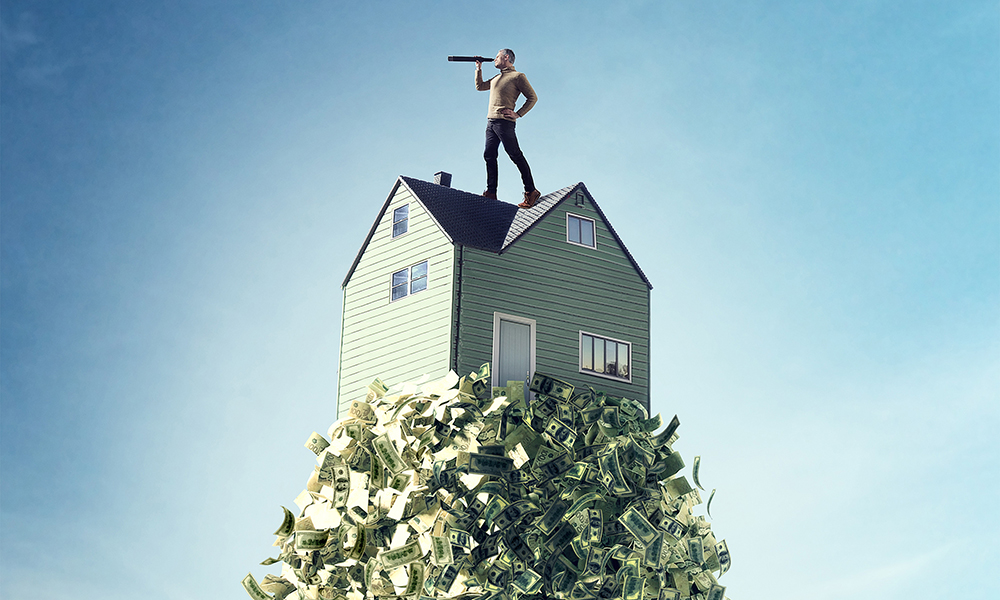
去年年初,美国炒房客退出市场;据Redfin统计,炒房客的购房数量骤减了约50%,与现房销量相差无几,据我们所知,现房销量降至近30年来的最低水平。
这与他们在疫情带来的房地产市场繁重期间的活动有所不同。当时,炒房客购房数量翻了一番以上。由于抵押贷款利率史上最低且远程办公流行,因此所有人都在买房。但随着抵押贷款利率飙升,一切都发生了改变,而且在有些地区房价和房租下跌,导致炒房客的利润大幅缩水。别忘了借款成本同样大幅上涨。
现在,炒房客们又回来了。Redfin表示:“炒房客购房数量在近两年来首次实现增长,尽管增长幅度较小。”在最新发布的一份分析报告中,Redfin发现炒房客在第一季度购买了44,000套住房,比去年同期增长了0.5个百分点。(Redfin对炒房客的定义是“购买住宅房地产的任何机构或企业”。)
Redfin表示,今年第一季度,炒房客几乎购买了19%的售出房屋,相当于他们买下了接近五分之一的住房。分析报告称,虽然房屋数量少于以前和疫情期间的水平,但却是近两年来的最高比例。
Redfin认为,炒房客回归的原因是,“随着房价和房租恢复上涨,以及抵押贷款利率上涨带来的初步冲击消失”,投资者正在“松开刹车”,纷纷进入市场。尽管如此,炒房客的获利也超过了一年前。今年3月,炒房客出售的普通住宅回报率超过55%,利润接近175,000美元。去年,在通常情况下,炒房客卖房的价格,比其购房价格高出超过146,000美元,涨幅超过了46%。很少有炒房客赔钱卖房。
Redfin的分析发现,炒房客正在购买比以前价格更贵的房子,而且他们购买的美国最经济实惠的住宅所占的比例也创下历史纪录。分析报告说道:“今年第一季度,炒房客购买的普通住房价格为464,560美元,同比上涨了9.2%。第一季度,炒房客购买的住房价值达到313亿美元,同比上涨6.6%。”
需要注意的是,虽然在第一季度,炒房客购买的更昂贵的住宅数量增长最快,但低价住宅依旧占更大比例。因此据Redfin统计,在第一季度炒房客购买的房屋中,低价住宅占47.5%,而高价住宅的比例为28.5%。炒房客购买的高价住宅增加的主要原因是加州的炒房客增多。在旧金山和圣地亚哥,第一季度售出的住宅有超过23%被炒房客买下,是除了佛罗里达州的迈阿密和杰克逊维尔以外,比例最高的城市。
但炒房客在旧金山的获利与费城等地不可同日而语;在旧金山,炒房客出售普通住宅的售价,比购买价上涨了近29%,但在费城,炒房客出售普通住宅的售价,比购买价高出超过136%。
虽然炒房客依旧会购买独栋住宅和多户住宅,今年第一季度,炒房客购买的独栋住宅增长了近4%,但他们购买的联排房屋、自有公寓和公寓楼等多户住宅的数量却有所减少。由于对独栋住宅(例如小户型的住宅)的理想化,美国人倾向于购买独栋住宅。据Redfin统计,第一季度,独栋住宅在炒房客购买的房屋中占比接近69%,而且比例还在不断扩大。
分析发现:“美国第一季度售出的独栋住宅,有18.4%被炒房客买下,这个比例为自2022年年中以来的新高。”与此同时,炒房客购买的其他类型地产的比例同比下降,多户住宅下降到31.9%,自有公寓/合作公寓和联排房屋的比例下降至18.1%。”
然而,在新泽西州的一位Redfin房屋中介说道:“炒房客与普通购房人之间的权力平衡正在发生变化。”这位房屋中介表示,当发生对一套房屋的竞价大战时,卖房人可能倾向于选择实际住在当地的购房人,而且在某些情况下,个人可能愿意比炒房客支付更高首付。
我们很少听说这种情况。但正如《财富》杂志之前的报道所说,大多数人估计,黑石集团(Blackstone)和Invitation Homes等机构投资者的所有权,在独栋住宅租赁中的占比不到5%,在所有独栋住宅中的占比不到1%。因此美国的房地产市场不景气,很难归咎于机构投资者。然而在有些市场情况却截然不同,例如在亚特兰大,机构投资者持有超过4%的独栋住宅,这可能是房屋成本更高的原因之一。
关于房地产市场存在炒房客的话题层出不穷,但我们可以确认的是,在经过近两年的蛰伏之后,他们又卷土重来,在房地产市场全面陷入停滞期间,炒房客的购房数量曾短暂下滑,但现在开始增长。当然这与疫情带来的房地产市场繁荣期间的情况,仍不能相提并论。(财富中文网)
翻译:刘进龙
审校:汪皓
去年年初,美国炒房客退出市场;据Redfin统计,炒房客的购房数量骤减了约50%,与现房销量相差无几,据我们所知,现房销量降至近30年来的最低水平。
这与他们在疫情带来的房地产市场繁重期间的活动有所不同。当时,炒房客购房数量翻了一番以上。由于抵押贷款利率史上最低且远程办公流行,因此所有人都在买房。但随着抵押贷款利率飙升,一切都发生了改变,而且在有些地区房价和房租下跌,导致炒房客的利润大幅缩水。别忘了借款成本同样大幅上涨。
现在,炒房客们又回来了。Redfin表示:“炒房客购房数量在近两年来首次实现增长,尽管增长幅度较小。”在最新发布的一份分析报告中,Redfin发现炒房客在第一季度购买了44,000套住房,比去年同期增长了0.5个百分点。(Redfin对炒房客的定义是“购买住宅房地产的任何机构或企业”。)
Redfin表示,今年第一季度,炒房客几乎购买了19%的售出房屋,相当于他们买下了接近五分之一的住房。分析报告称,虽然房屋数量少于以前和疫情期间的水平,但却是近两年来的最高比例。
Redfin认为,炒房客回归的原因是,“随着房价和房租恢复上涨,以及抵押贷款利率上涨带来的初步冲击消失”,投资者正在“松开刹车”,纷纷进入市场。尽管如此,炒房客的获利也超过了一年前。今年3月,炒房客出售的普通住宅回报率超过55%,利润接近175,000美元。去年,在通常情况下,炒房客卖房的价格,比其购房价格高出超过146,000美元,涨幅超过了46%。很少有炒房客赔钱卖房。
Redfin的分析发现,炒房客正在购买比以前价格更贵的房子,而且他们购买的美国最经济实惠的住宅所占的比例也创下历史纪录。分析报告说道:“今年第一季度,炒房客购买的普通住房价格为464,560美元,同比上涨了9.2%。第一季度,炒房客购买的住房价值达到313亿美元,同比上涨6.6%。”
需要注意的是,虽然在第一季度,炒房客购买的更昂贵的住宅数量增长最快,但低价住宅依旧占更大比例。因此据Redfin统计,在第一季度炒房客购买的房屋中,低价住宅占47.5%,而高价住宅的比例为28.5%。炒房客购买的高价住宅增加的主要原因是加州的炒房客增多。在旧金山和圣地亚哥,第一季度售出的住宅有超过23%被炒房客买下,是除了佛罗里达州的迈阿密和杰克逊维尔以外,比例最高的城市。
但炒房客在旧金山的获利与费城等地不可同日而语;在旧金山,炒房客出售普通住宅的售价,比购买价上涨了近29%,但在费城,炒房客出售普通住宅的售价,比购买价高出超过136%。
虽然炒房客依旧会购买独栋住宅和多户住宅,今年第一季度,炒房客购买的独栋住宅增长了近4%,但他们购买的联排房屋、自有公寓和公寓楼等多户住宅的数量却有所减少。由于对独栋住宅(例如小户型的住宅)的理想化,美国人倾向于购买独栋住宅。据Redfin统计,第一季度,独栋住宅在炒房客购买的房屋中占比接近69%,而且比例还在不断扩大。
分析发现:“美国第一季度售出的独栋住宅,有18.4%被炒房客买下,这个比例为自2022年年中以来的新高。”与此同时,炒房客购买的其他类型地产的比例同比下降,多户住宅下降到31.9%,自有公寓/合作公寓和联排房屋的比例下降至18.1%。”
然而,在新泽西州的一位Redfin房屋中介说道:“炒房客与普通购房人之间的权力平衡正在发生变化。”这位房屋中介表示,当发生对一套房屋的竞价大战时,卖房人可能倾向于选择实际住在当地的购房人,而且在某些情况下,个人可能愿意比炒房客支付更高首付。
我们很少听说这种情况。但正如《财富》杂志之前的报道所说,大多数人估计,黑石集团(Blackstone)和Invitation Homes等机构投资者的所有权,在独栋住宅租赁中的占比不到5%,在所有独栋住宅中的占比不到1%。因此美国的房地产市场不景气,很难归咎于机构投资者。然而在有些市场情况却截然不同,例如在亚特兰大,机构投资者持有超过4%的独栋住宅,这可能是房屋成本更高的原因之一。
关于房地产市场存在炒房客的话题层出不穷,但我们可以确认的是,在经过近两年的蛰伏之后,他们又卷土重来,在房地产市场全面陷入停滞期间,炒房客的购房数量曾短暂下滑,但现在开始增长。当然这与疫情带来的房地产市场繁荣期间的情况,仍不能相提并论。(财富中文网)
翻译:刘进龙
审校:汪皓
At the start of last year, investors pulled back; their home purchases plummeted almost 50%, according to Redfin, not too far off from existing home sales, which as we know fell to their lowest point in almost 30 years.
It was a change from their activity throughout the pandemic-fueled housing boom though. At that time, investor home purchases more than doubled. Everyone was buying homes because mortgage rates were historically low and remote work became a thing. It all changed when mortgage rates soared, and in some areas, home values declined and rents cooled—putting a dent in investors’ profits. And let’s not forget borrowing costs were much higher too.
Now, they’re back. “Investor home purchases are rising—albeit slightly—for the first time in almost two years,” according to Redfin. In a newly published analysis, Redfin found investors bought 44,000 homes in the first quarter, up half a percent from a year earlier. (Redfin defines an investor as “any institution or business that purchases residential real estate.”)
Investors bought almost 19% of homes sold in the first quarter this year, so roughly one in five homes, per Redfin. That’s fewer homes than before and throughout the pandemic, but it is the highest share in close to two years, the analysis read.
The rationale behind the return being, “with home prices and rents back on the rise and the initial shock of elevated mortgage rates in the rearview mirror, investors are easing their foot off the brake pedal,” according to Redfin. That being said, they’re making more money than they were a year ago, too. In March of this year, the typical home sold by an investor drove a slightly more than 55% return, or close to $175,000 profit. Last year, in the typical situation, an investor sold a home for more than $146,000 than they bought it for, or above 46%. Fewer investors sold at a loss too.
Redfin’s analysis found investors are buying both more expensive homes than before—and a record share of the most affordable homes in the country. “The typical home bought by investors in the first quarter cost $464,560, up 9.2% from a year earlier,” it said. “Investors purchased $31.3 billion worth of homes in the first quarter, up 6.6% year over year.”
Here’s the thing, while their purchases of more expensive homes increased the most in the first quarter, low-priced homes still represent a larger share. So low-priced homes amounted to 47.5% of investor purchases in the first quarter, but high-priced homes amounted to 28.5%, according to Redfin. And a lot of the increase in their more expensive home purchases were driven by investors’ growing presence in California. In San Francisco and San Diego, investors bought more than 23% of homes sold in the first quarter, some of the highest shares apart from cities in Florida, such as Miami and Jacksonville.
But their profit in San Francisco doesn’t compare to let’s say Philadelphia; In the former, the typical home sold by an investor sold for close to 29% more than the investor bought it for—in the latter, the typical home sold by an investor sold for slightly over 136% more than the investor bought it for.
And while investors are still buying single-family and multifamily homes, their purchases of single-family homes rose in the first quarter of the year by nearly 4%, but their multifamily purchases fell across townhouses, condos, and apartments. In this country there’s demand for single-family homes fueled by an idealization of them (consider tiny homes). Single-family homes made up close to 69% of investor purchases in the first quarter, according to Redfin, and they’ve gained market share.
The analysis found: “18.4% of U.S. single-family homes that sold in the first quarter were purchased by investors—the highest share since mid-2022. Meanwhile, the share of other property types bought by investors fell from a year earlier, to 31.9% for multifamily properties and 18.1% for both condos/co-ops and townhouses.”
However, a New Jersey-based Redfin agent said: “The balance of power between investors and regular buyers is changing.” The agent suggested that when there’s a bidding war for a home, sellers may prefer to choose the person who will actually be living there, and in some cases, individuals might actually be willing to pay more upfront than investors.
It’s not often you hear that. But as Fortune has previously reported, most estimates put ownership of institutional investors, like Blackstone and Invitation Homes, at less than 5% of single-family rentals and less than 1% of all single-family homes. So it can be hard to blame them for all the country’s housing woes. However, it is a different story when it comes to some markets, such as Atlanta, where institutional investors own more than 4% of all single-family homes, and it could be contributing to higher housing costs.
The conversation surrounding investors in the housing world is layered, but what we know is they are back after an almost two-year hiatus, and their purchases are on the rise after a short-lived slump amid an all around frozen housing market. Still, it is no match to what was experienced during the pandemic housing frenzy.






